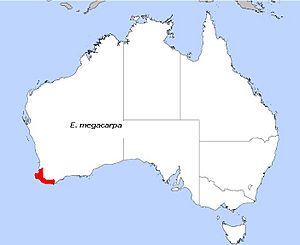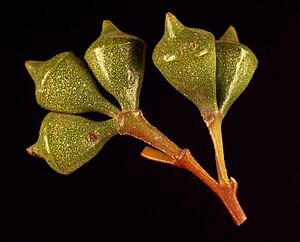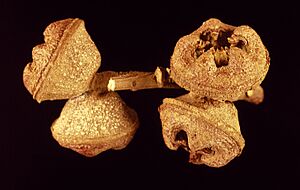Bullich facts for kids
Quick facts for kids Bullich |
|
|---|---|
 |
|
| Eucalyptus megacarpa, in Maranoa Gardens | |
| Scientific classification | |
| Genus: |
Eucalyptus
|
| Species: |
megacarpa
|
 |
|
| E. megacarpa, field distribution | |
The Bullich (scientific name: Eucalyptus megacarpa) is a special type of eucalyptus tree. It is also known by its Noongar name, bullich. This tree grows in the forests of southwestern Western Australia.
It can be a strong, bushy plant called a mallee, or a small to medium-sized tree. The Bullich has smooth bark and leaves shaped like a spear or slightly curved. Its flower buds grow in groups of three, and the flowers are white. The fruit looks like a cup, bell, or half-sphere.
Contents
What Does Bullich Look Like?
The Bullich tree usually grows to be about 20 to 35 meters (65 to 115 feet) tall. If it grows as a mallee, it can reach about 5 meters (16 feet). It has a special woody swelling at its base called a lignotuber. This helps it regrow after a fire.
The bark is smooth all over. It can be mottled grey, reddish-grey, or white. Young plants have broad, spear-shaped leaves. These leaves are about 100 to 130 mm (4 to 5 inches) long.
Adult leaves are a dull to slightly shiny green on both sides. They are spear-shaped or curved, about 70 to 140 mm (3 to 5.5 inches) long. These leaves grow on a stalk called a petiole, which is 13 to 35 mm (0.5 to 1.4 inches) long.
The flower buds grow in groups of three. They are found where the leaves meet the stem. Each group of buds sits on a flat stalk called a peduncle, about 12 to 20 mm (0.5 to 0.8 inches) long. Each individual bud has a tiny stem called a pedicel, up to 4 mm (0.16 inches) long.
When the buds are ready, they are oval or pear-shaped. They are about 15 to 22 mm (0.6 to 0.9 inches) long and 12 to 17 mm (0.5 to 0.7 inches) wide. They have a beak-like cap called an operculum.
Bullich flowers are white and bloom between April and November. After flowering, the fruit forms. It is a woody capsule shaped like a cup, bell, or half-sphere. These fruits are 12 to 19 mm (0.5 to 0.75 inches) long and 18 to 30 mm (0.7 to 1.2 inches) wide.
How Was Bullich Named?
The scientific name Eucalyptus megacarpa was first officially described in 1860. A famous botanist named Ferdinand von Mueller did this. He wrote about it in his book Fragmenta phytographiae Australiae.
He used samples collected by George Maxwell near Wilson Inlet in 1858. The second part of the name, megacarpa, comes from Latin. It means "large-fruited," which describes its big fruits.
Where Does Bullich Grow?
Bullich trees grow in forests near swamps and along stream banks. The smaller mallee form can also be found on hillsides. You can find it from near Perth down to Cape Leeuwin and Albany. It also grows in the Stirling Range.
It prefers sandy soils or sandy loam soils that are over limestone.
Is Bullich Protected?
The Western Australian Government's Department of Parks and Wildlife says that this eucalypt is "not threatened." This means it is not currently at risk of disappearing.
How Can We Use Bullich?
Bullich is sold for planting as seeds or as small plants called tube stock. It grows well in full sun. It can also handle long dry periods and light frost.
This tree can grow in different types of soil. It grows at an average speed. People often plant it as a shade tree in natural-style gardens. It is also good for attracting birds.
See also
 In Spanish: Bullich para niños
In Spanish: Bullich para niños



